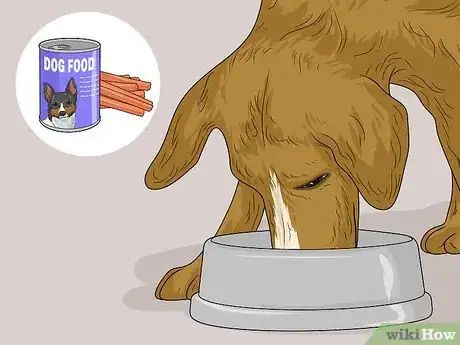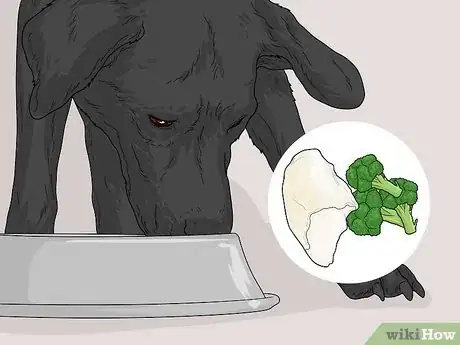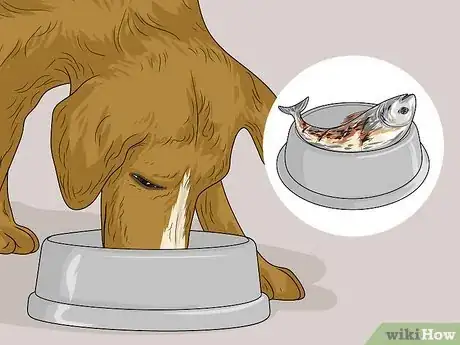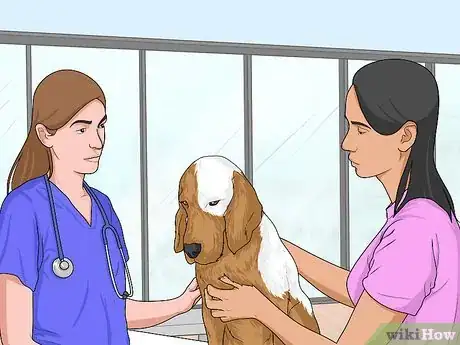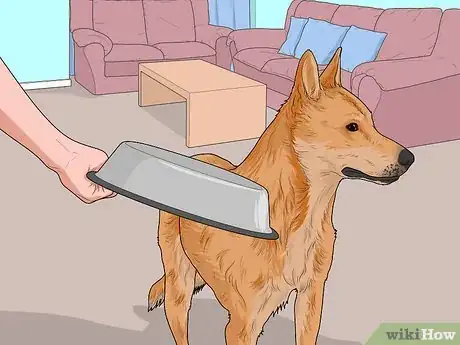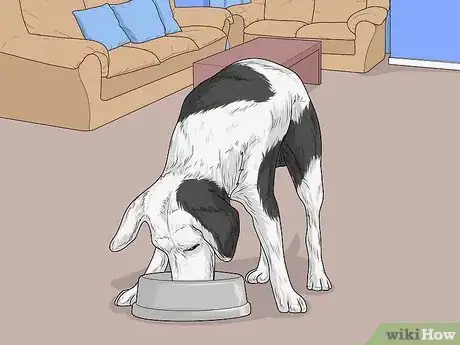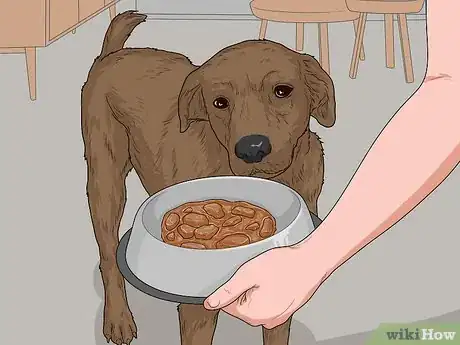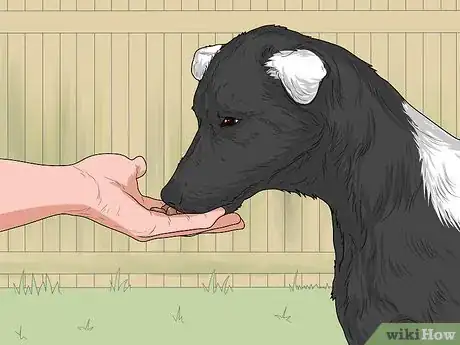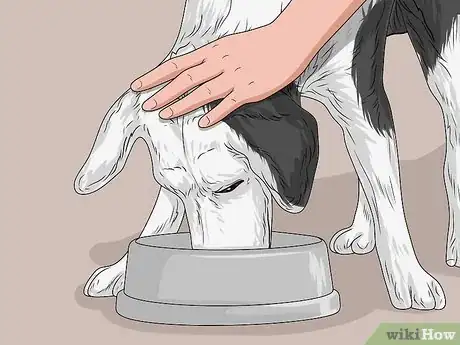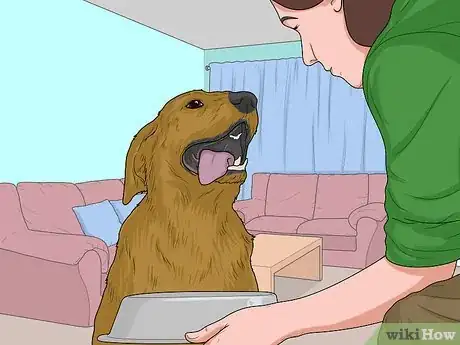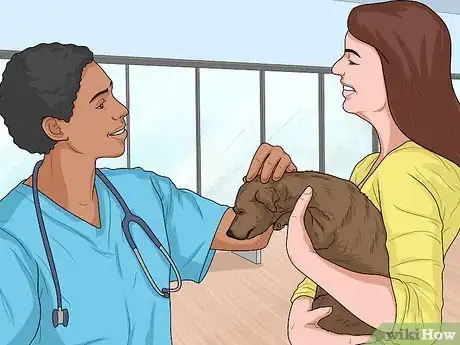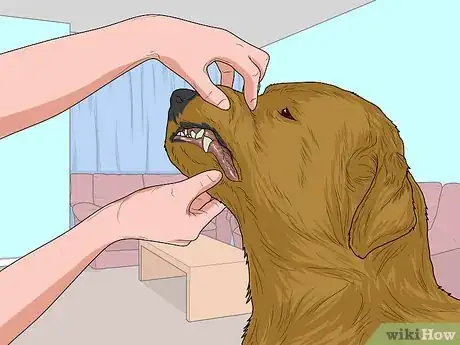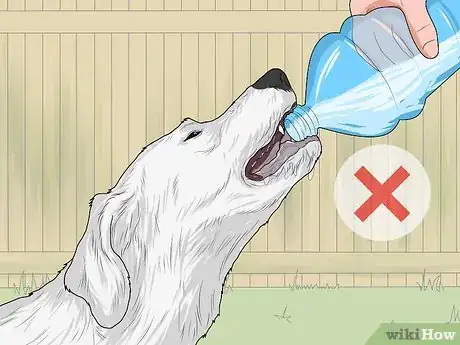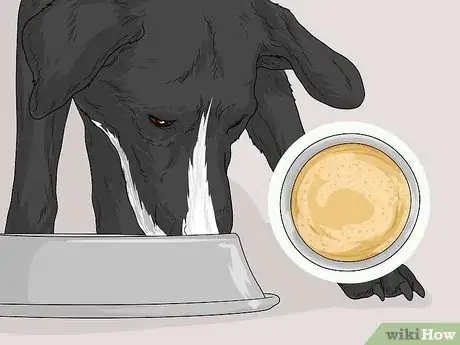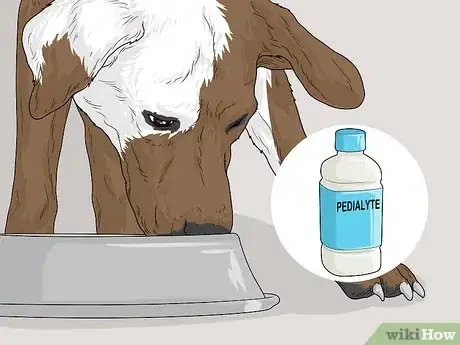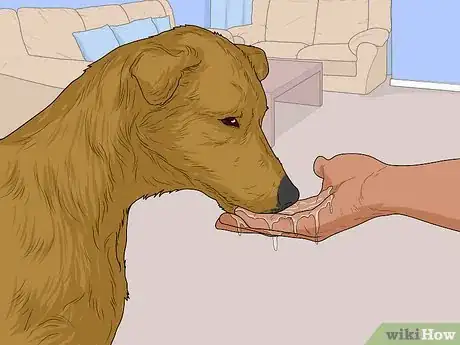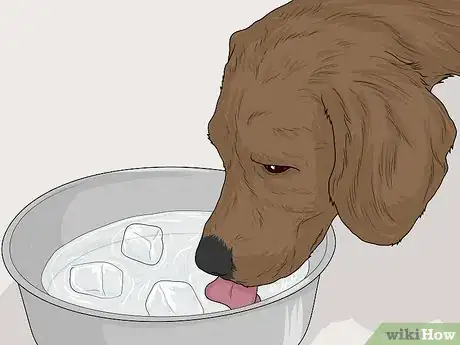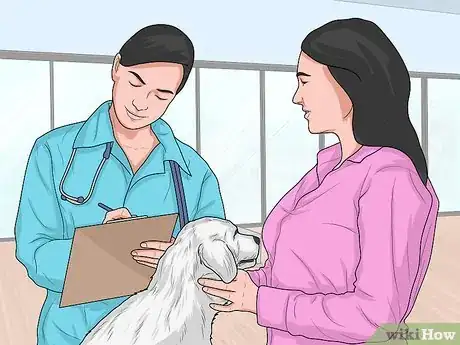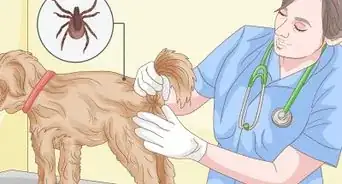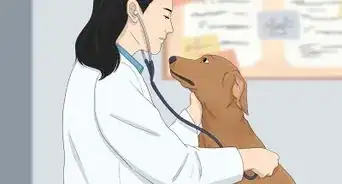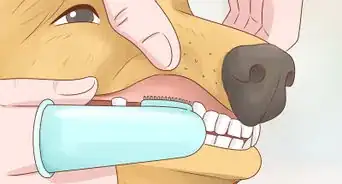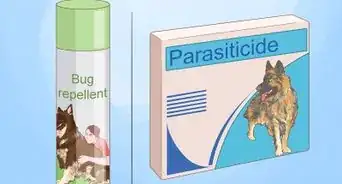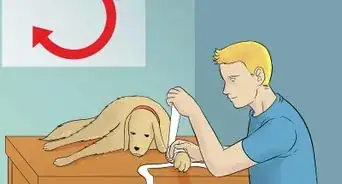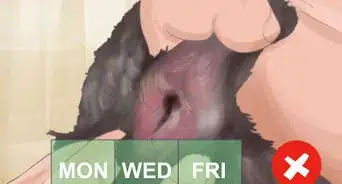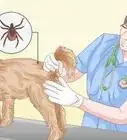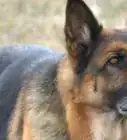This article was co-authored by Belgin Altundag. Belgin Altundag is a Certified Dog Trainer and the Owner of Happy Doggies Day Care/Day Camp in West Hollywood, California. A passionate animal lover, Belgin is knowledgeable about multiple training styles, including obedience training, problem-solving, activity training, and behavior modification. In addition to being an Animal Behavior College’s Certified Dog Trainer (ABCDT), Belgin has also completed the Training Cesar's Way Fundamentals of Dog Behavior and Training Programs 1 and 2 and is certified by the American Red Cross in Cat and Dog First-Aid.
There are 9 references cited in this article, which can be found at the bottom of the page.
This article has been viewed 101,691 times.
Sometimes when a dog is sick, she refuses to eat. No matter what you do, the dog just turns her nose up at what you offer. However, there are things you can do to encourage your dog to eat.
Steps
Trying Different Food
-
1Change the dog's diet. If your dog isn't interested in her usual food, try giving her something new and special. This might encourage her to eat. Just make sure to think about the underlying illness when choosing foods. Try giving your dog:
- Canned pet food
- Carrot sticks
- Boiled chicken, hamburger meat, tuna, sandwich meat, or other mild meats
- Meat-flavored or other flavored baby food
- Peanut butter
- Pet snacks or treats
- Small amounts of cat food[1]
- Rice[2]
- Vegetables, like mashed pumpkin or sweet potato
- No-salt added chicken broth[3]
- Cream of wheat (a.k.a. farina) or oatmeal[4]
-
2Try bland food. If your dog has diarrhea, nausea, or is vomiting, you need to feed her bland foods. Rich or fatty foods won't be good for a dog with these symptoms. Instead, feed her vegetables, cream of wheat or oatmeal, boiled chicken, or no-salt-added chicken broth.[5]
- Be aware that hamburger meat can be too greasy if your dog has stomach issues. Don't feed her greasy foods if she's dealing with these symptoms.
Advertisement -
3Keep the portion size small. When a dog refuses to eat, getting nutrients into her is important. Try feeding her smaller amounts, just one or two spoonfuls to start. Little and often is ideal, so offering a spoonful (depending on the size of the dog) every hour, rather than one big meal a day, can do the trick.[6]
-
4Let the dog eat grass. Eating grass is an instinct for dogs when they're feeling sick. The grass may stimulate her to be sick. This is nature's way of cleansing the system and purging it of toxins.[7]
- If your dog vomits more than a couple times, or eats grass and vomits every time she goes outside, call the vet.
-
5Choose foods that have an odor. Sometimes, a dog doesn't want to eat because she is old, has aches and pains, or can't smell the food. Scent plays a big part in encouraging a dog to eat, so offer something that is naturally smelly, such as fish. You can also try warming the food up slightly so that it gives off an odor.[8]
-
6Give your dog wet food. Sometimes, dry kibble is not appetising to a sick dog. Dry food can cause pain, irritate the dog's throat, or hurt the teeth and gums. Switch to a moist food while your dog is sick. Wet food can be easier for her to digest.[9]
- You can also mix in broth, beef bouillon, tomato soup, or tomato juice with the dry kibble to make it moist and easier to eat and digest.
-
7Talk to your vet about a special diet. If your dog is only taking in small amounts of food, speak to your vet about special prescription diets that are energy dense. These foods are packed with nutrition for the dog and often contain four times the calories of an equivalent sized can of food. However, they may not be suitable for all dogs, depending on the nature of the dog's underlying problem.[10]
Using Different Techniques
-
1Do not force the dog to eat. It's important that you don't force your dog to eat. The dog could feel nauseous and might vomit if she eats. Instead, let the dog do what she feels is natural. A dog not eating for up to 24 hours is no cause for concern. Even 48 hours without eating is okay if she is drinking water.[11]
-
2Try feeding in a new room. Feed your dog in a room she doesn't normally eat in. The break with routine, curiosity factor, and the fact that she has no previous associations with nausea in the room can help kick start her appetite.[12]
-
3Introduce food slowly. If you are changing your dog's food, it could make her sick. Instead of making a sudden switch, phase in the new food as you phase out the old over a week. Watch your dog carefully to make sure the new food is agreeing with her and not making her sick.[13]
-
4Hand feed your dog. Sit beside your dog, dip your fingers into the canned food, and then offer them up to her mouth. This often does the trick. Try dabbing a bit of the food on the dog's nose or lip, so that she licks it off to clean herself and gets a taste of the food in her mouth. Sometimes tasting the food helps the dog to realize she is hungry and makes her want to try the food.[14]
-
5Give your dog praise while eating. Praising your dog while she eats may encourage her to start eating again. If she licks food from your hand, eats a bite from a spoon or bowl, or ingests anything else, give her lots of praise so that her good behavior is rewarded. You can also scratch your dog's head or neck while feeding her.[15]
- However, only reserve this for genuinely sick dogs, or you may accidentally train your dog only to eat when hand fed.
-
6Be patient and gentle with your dog. The most important thing is to be patient while your dog refuses to eat. It is frustrating when she refuses food, but venting your feelings will do nothing to help the dog's appetite. Don't take your frustrations out on your dog.[16]
-
7See the vet. If none of these tips work, take the dog to the vet. If your dog hasn't eaten in 24 to 48 hours, take her to the vet. Also, take her to the vet if she has been vomiting a lot or has persistent diarrhea.[17] [18]
- You should also take your dog to the vet if notice any blood in their stool.[19]
Preventing Dehydration
-
1Check for dehydration. When a dog isn't eating, oftentimes she isn't drinking either. Dehydration is a major concern and can cause serious problems. Keep an eye on your dog to make sure she doesn't become dehydrated. To do this, check her gums. They should be pink, wet, and slick, not dry. You can also press a finger to your dog's gums until they change color. When you remove your finger, the color should return immediately. If it takes a few moments, the dog may be dehydrated.[20]
- Dogs who are vomiting or who have diarrhea are at a high risk for dehydration.
- Make sure that your dog always has access to clean water.[21]
-
2Do not force your dog to drink. Never try to force water down your dog's throat. Forcing water down her throat can cause more problems if she doesn't swallow. Instead, try techniques to encourage her to drink on her own.[22]
-
3
-
4Give your dog Pedialyte. Unflavored Pedialyte, which is a drink for children containing electrolytes, can help your dog if she has not been eating or drinking. The Pedialyte can help replace much needed electrolytes.[25]
-
5Let your dog lick water from something. Sometimes, you can get your dog to lick a wet surface so she can get some water. See if your dog will lick water from your hand or fingers. You can also try to see if your dog will lick an ice cube.[26]
-
6Add ice to the dog's water. Sometimes, adding an ice cube to your dog's water can help. She might be more willing to drink it with the ice cube inside, which makes the water cooler.[27]
- Some pets like to drink running water instead of still water, so also try a drinking fountain to encourage your dog to drink.[28]
-
7Take the dog to the vet. Dehydration can cause serious problems. If your dog refuses to drink anything, take her to the vet. The vet can give her fluids through an IV and find out if there is an underlying condition.[29]
References
- ↑ http://www.petplace.com/article/dogs/keeping-your-dog-healthy/feeding-nutrition/encouraging-your-sick-dog-to-eat
- ↑ http://www.caninejournal.com/cure-dogs-upset-stomach/
- ↑ https://www.petcarerx.com/article/what-to-feed-a-sick-dog-so-theyll-feel-better/1380
- ↑ https://www.vetinfo.com/tips-feeding-sick-dog.html
- ↑ http://www.caninejournal.com/cure-dogs-upset-stomach/
- ↑ http://www.petplace.com/article/dogs/keeping-your-dog-healthy/feeding-nutrition/encouraging-your-sick-dog-to-eat
- ↑ https://www.petcarerx.com/article/what-to-feed-a-sick-dog-so-theyll-feel-better/1380
- ↑ http://www.vetstreet.com/dr-marty-becker/help-your-sick-or-senior-pet-feel-better
- ↑ https://www.vetinfo.com/what-to-do-if-your-sick-dog-wont-eat.html
- ↑ Small animal internal medicine. Nelson & Couto. Mosby.
- ↑ https://www.petcarerx.com/article/what-to-feed-a-sick-dog-so-theyll-feel-better/1380
- ↑ http://www.petplace.com/article/dogs/keeping-your-dog-healthy/feeding-nutrition/encouraging-your-sick-dog-to-eat
- ↑ http://www.caninejournal.com/cure-dogs-upset-stomach/
- ↑ http://www.vetstreet.com/dr-marty-becker/help-your-sick-or-senior-pet-feel-better
- ↑ http://www.vetstreet.com/dr-marty-becker/help-your-sick-or-senior-pet-feel-better
- ↑ https://www.petcarerx.com/article/what-to-feed-a-sick-dog-so-theyll-feel-better/1380
- ↑ https://www.vetinfo.com/what-to-do-if-your-sick-dog-wont-eat.html
- ↑ Belgin Altundag. Certified Dog Trainer. Expert Interview. 11 August 2021.
- ↑ Belgin Altundag. Certified Dog Trainer. Expert Interview. 11 August 2021.
- ↑ https://www.petcarerx.com/article/what-to-feed-a-sick-dog-so-theyll-feel-better/1380
- ↑ Belgin Altundag. Certified Dog Trainer. Expert Interview. 11 August 2021.
- ↑ https://www.vetinfo.com/what-to-do-if-your-sick-dog-wont-eat.html
- ↑ https://www.vetinfo.com/tips-feeding-sick-dog.html
- ↑ http://www.1800petmeds.com/education/feeding-sick-dogs-cats-33.htm
- ↑ https://www.petcarerx.com/article/what-to-feed-a-sick-dog-so-theyll-feel-better/1380
- ↑ https://www.vetinfo.com/what-to-do-if-your-sick-dog-wont-eat.html
- ↑ https://www.vetinfo.com/what-to-do-if-your-sick-dog-wont-eat.html
- ↑ http://www.vetstreet.com/dr-marty-becker/help-your-sick-or-senior-pet-feel-better
- ↑ https://www.petcarerx.com/article/what-to-feed-a-sick-dog-so-theyll-feel-better/1380
About This Article
To feed a sick dog, try enticing it to eat by giving it tasty treats like boiled chicken, hamburger meat, or mashed sweet potato. If your dog has diarrhea, nausea, or is vomiting, stick to bland, non-fatty foods, such as rice, plain chicken, or oatmeal. You can also try feeding your dog smaller amounts, around 1 to 2 spoonfuls every hour, instead of 1 big meal a day. However, make sure to be patient if your dog refuses to eat since dogs can go up to 48 hours without eating, as long as they’re drinking water. For more advice from our Veterinary reviewer, including how to prevent dehydration in your dog, keep reading.
